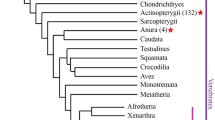Summary
To have a better understanding of the evolutionary history of mobile elements within the nematodes, we examined the distribution and the conservation of homologues to transposable elements fromCaenorhabditis elegans (Tc1, Tc2, Tc3, Tc4, Tc5, and FB1) in 19 nematode species belonging to the class Secernentea. Our results show that Tc1 elements display a distribution restricted to the family Rhabditidae with poor conservation. The Tc2 and FB1 homologous elements have the same patchy distribution within the Rhabditidae. They were only found inCaenorhabditis and inTeratorhabditis. The Tc3 element is widely distributed among nematode species. Tc3 homologous elements are present in the majority of the Rhabditidae but also in two genera within the family Panagrolaimidae, and inBursaphelenchus, which belongs to the order Aphelenchida. Tc4 and Tc5 homologues show the most limited distribution of all tested elements, being strictly limited toC. elegans. These data indicate that in some cases, the distribution of transposable elements in the nematode cannot be explained by strict vertical transmission. The distribution of Tc3, Tc4, and Tc5 suggests that horizontal transmission may have occurred between reproductively isolated species during their evolutionary history.
Similar content being viewed by others
References
Abad P, Vaury C, Pélisson A, Chaboissier M-C, Busseau I, Bucheton A (1989) A long interspersed repetitive element-the I factor ofDrosophila teissieri-is able to transpose in differentDrosophila species. Proc Natl Acad Sci USA 86:8887–8891
Benian GM, Kiff JE, Neckelmann N, Moerman DG, Waterston RH (1989) Sequence of an unusually large protein implicated in regulation of myosin activity inC. elegans. Nature 342:45–50
Brégliano J-C, Kidwell MG (1983) Hybrid dysgenesis determinants. In: Shapiro J (ed) Mobile genetic elements. Academic Press, New York, pp 304–404
Brezinsky L, Wang GVL, Humphreys T, Hunt J (1990) The transposable element Uhu from HawaiianDrosophila member of the widely dispersed class of Tc1-like transposons. Nucleic Acids Res 18:2053–2055
Bucheton A (1990) I transposable elements and I-R hybrid dysgenesis inDrosophila. Trends Genet 6:16–21
Bucheton A, Simonelig M, Vaury C, Crozatier M (1986) Sequences similar to the I transposable element involved in I-R hybrid dysgenesis inD. melanogaster occur in otherDrosophila species. Nature 322:561–563
Emmons SW, Klass MR, Hirsh D (1979) Analysis of the constancy DNA sequences during development and evolution of the nematodeCaenorhabditis elegans. Proc Natl Acad Sci USA 76:1333–1337
Engels WR (1989) P elements inDrosophila melanogaster. In: Berg DE, Howe MH (eds) Mobile DNA. American Society for Microbiology, Washington DC, pp 437–484
Federoff NV (1989) Maize transposable elements. In: Berg DE, Howe MH (eds) Mobile DNA. American Society for Microbiology, Washington DC, pp 375–412
Feinberg AP, Vogelstein B (1983) A technique for radiolabeling DNA restriction endonuclease fragments to high specific activity. Anal Biochem 132:6–13
Finnegan DJ (1989) Eukaryotic transposable elements and genome evolution. Trends Genet 5:103–105
Finnegan DJ, Fawcett DH (1986) Transposable elements inDrosophila melanogaster. In: Maclean N. (ed) Oxford survey on eukaryotic genes, vol 3. Oxford University Press
Goodey T (1963) Soil and freshwater nematodes, ed 2. Wiley & Sons, New York
Harris LJ, Baillie DL, Rose AM (1988) Sequence identity between an inverted repeat family of transsposable elements inDrosophila andCaenorhabditis. Nucleic Acids Res 16:5591–5598
Lansman RA, Stacey SN, Grigliatti TA (1985) Sequences homologous to the P mobile element ofDrosophila melanogaster are widely distributed in the subgenusSophophora. Nature 318:561–563
Maniatis T, Fritsch EF, Sambrook J (1982) Molecular cloning: a laboratory manual. Cold Spring Harbor Laboratory, Cold Spring Harbor NY
Moerman DG, Waterston RH (1984) Spontaneous instableunc-22 IV mutations inC. elegans var. Bergerac. Genetics 108: 859–877
Moerman DG, Waterston RH (1989) Mobile elements inCaenorhabditis elegans and other nematodes. In: Berg DE, Howe MH (eds) Mobile DNA. American Society for Microbiology, Washington DC, pp 537–556
Parkhurst SM, Corces VG (1986) Interactions among the gypsy transposable element and the yellow and the suppressor-of-hairy-wing inDrosophila melanogaster. Mol Cell Biol 6:47–53
Poinar GO (1983) The natural history of nematodes. Prentice-Hall, Englewood Cliffs NJ
Rigby PW, Dieckmann M, Rhodes C, Berg P (1977) Labelling deoxyribonucleic acid to high specific activity in vitro by nicktranslation with DNA polymerase. J Mol Biol 113:327–351
Rosenzweig B, Liao L, Hirsh D (1983) Sequence of theC. elegans transposable element Tc1. Nucleic Acids Res 11:4201–4209
Southern EM (1975) Detection of specific sequence among DNA fragments separated by gel electrophoresis. J Mol Biol 98: 503–517
Sulston JE, Brenner S (1974) The DNA ofCaenorhabditis elegans. Genetics 77:94–104
Author information
Authors and Affiliations
Rights and permissions
About this article
Cite this article
Abad, P., Quiles, C., Tares, S. et al. Sequences homologous to Tc(s) transposable elements ofCaenorhabditis elegans are widely distributed in the phylum nematoda. J Mol Evol 33, 251–258 (1991). https://doi.org/10.1007/BF02100676
Received:
Revised:
Issue Date:
DOI: https://doi.org/10.1007/BF02100676




